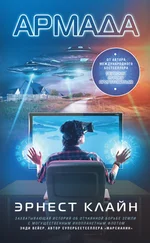The ship’s onboard computer contained a new standalone virtual-reality simulation for us to access on our long journey. After much debate over what we should call our new virtual realm, we finally agreed upon the name ARC@DIA. (It was Aech’s idea to replace the a in the middle with an @ sign, to give the name a l33t flourish and to help distinguish it from the geographic region in central Greece, the Duran Duran side project, the city on Gallifrey, the alternate plane of reality in Dungeons & Dragons, and all of the other Arcadias out there.) The addition of the @ was also fitting because, as Aech put it, “ARC@DIA will be where it’s at!”
ARC@DIA was going to serve as our own private scaled-down version of the OASIS during the voyage. It was still a work in progress, and likely would be until the day we departed. Due to various space and hardware limitations, our simulation wasn’t nearly as big—about half the size of one OASIS sector. But that was still a vast amount of virtual space for us and our tiny crew to inhabit. We had enough room to upload copies of more than two hundred of our favorite OASIS planets, along with their NPCs. We didn’t bother transferring any of the business content or retail planets over. Where we were going, we wouldn’t need stores or commerce. Besides, we had to be sparing with our data-storage space, since we were bringing along a backup copy of the entire ONI-net file database too. It was updated every night, along with new OASIS content.
There was one other thing that made our simulation different from its predecessor. Unlike the OASIS, ARC@DIA could only be accessed via a neural-interface headset. (We didn’t want to waste any time, space, or money bringing outdated haptic technology along.)
The Vonnegut was still about a year from being complete, but Aech, Shoto, and I were in no rush. We weren’t eager to leave the Earth behind for a long, cramped, and perilous voyage. And we weren’t ready to give up on Planet Earth yet either. Not while there was still a chance we could save it. What we were doing was doomsday-prepping on a multibillionaire scale, packing the ultimate bugout bag—the means to escape the planet if, and when, everything went to shit.
We’d concealed the details of the Vonnegut Project from the world (and from Samantha) for as long as we could. But eventually word of what we were up to leaked to the press. Of course, Samantha was furious when she found out we’d spent over three hundred billion dollars to build a ship to escape our dying planet instead of using that money and manpower to help her try to save it.
I told her we were saving a spot for her on the Vonnegut ’s crew, but you can imagine how that went over. She stormed out, then she crucified us in the press. She accused us of sabotaging humanity by releasing the ONI to the masses and then using the profits to build a lifeboat to save our own skin.
But I didn’t see it that way. And thankfully, neither did Aech or Shoto. We admired Samantha’s optimism, and maybe—on a good day—even shared in it. But with Earth teetering on the brink of destruction, leaving our eggs in one basket was foolish. Sending a small contingent of humanity out into space was the only responsible thing to do—and at this precarious moment in history, we were the only three people on the planet with the resources to do it.
After two dozen laps inmy heated indoor Olympic-size swimming pool—which, thanks to my AR swim goggles, was teeming with rare tropical fish and even a pod of friendly dolphins to keep me company—I was standing in my walk-in closet, surrounded by tailored suits and designer clothes I had never worn and probably never would. I wore the same outfit every day, so I never had to expend any thought on what to wear next. I got the idea from Jeff Goldblum in The Fly, and he, in turn, got it from Albert Einstein.
I was equally disciplined about my daily workout, even when I was feeling under the weather. Exercising for at least two hours every day was an absolute necessity, since I frequently spent over eleven hours a day logged in to the OASIS with my ONI headset, followed by another eight hours of sleep on top of that. For me, it seemed to take at least two hours of vigorous exercise to balance out the twenty or so hours of each day that I spent not moving at all.
Like eating and sleeping, exercise was one of the things people still had to do in reality. None of the simulated physical activity you experienced through your ONI headset actually had any real-world effects, like improving your circulation or increasing your muscle tone.
I finished lacing up my vintage Air Jordans and stepped outside onto the balcony, where my usual breakfast was waiting for me. As I took a seat at the table, one of my humanoid service robots, Belvedere, uncovered my omelet and hash browns and poured me a glass of freshly squeezed orange juice. Then he retreated to the corner of the balcony and stood there like a statue, waiting to be of further use.
I’d programmed Belvedere never to speak unless spoken to, because his synthesized voice set me on edge, regardless of how much I tweaked his tone or inflection. Probably because I’d seen too many robot-uprising movies.
There wasn’t any actual chance of my service robots staging a revolt, of course. Like most of the artificial intelligence people interacted with on a daily basis, Belvedere and his fellow household bots were Tier One AI, which was classified as “extremely weak.” Tier One AI was used to operate service robots, drive automated cars, and fly automated planes. All of our OASIS NPCs were Tier Ones.
Tier Two AI was used mostly for science and military applications, and their use and operating parameters were heavily restricted by most world governments. Tier Twos could form short-term memories and had stronger independent learning abilities—but they still did not have the capacity for autonomy, or any sort of identity or self-awareness.
Tier Three AI was the real deal—fully autonomous, self-aware, and conscious. The kind that science fiction films warn you about. This level of artificial intelligence was still theoretical, praise be to Crom. But according to GSS’s top engineers, probably not for much longer. The race to create true artificial intelligence had become like the race to create the atomic bomb. Several different countries—including my own—were working to create full-blown self-aware, as-smart-if-not-smarter-than-the-average-human-being artificial intelligence. Maybe some of them already had, and now it was just a waiting game to see who would unleash it first, probably in an army of sentient aerial drones and battle telebots that said “Roger, Roger” to one another while machine-gunning civilian populations. That was, if we didn’t nuke ourselves into oblivion first.
I ate in silence for a few minutes, staring up at the sky overhead. When I finished my food, I put my AR specs on again and used them to log in to my OASIS account. Then I used a heavily encrypted remote-access code to take control of a telebot—a humanoid telepresence robot—that was located in orbit high above the Earth aboard the Vonnegut . Once my link to the bot was established, my AR specs allowed me to see through its “eyes”—a set of stereoscopic video cameras mounted in its head. I disconnected the telebot from its charging dock, which was anchored to a bulkhead in the ship’s forward cargo hold. This was in the ring-shaped section of the craft, which rotated constantly to generate centripetal force and create simulated gravity.
I piloted the telebot over to a circular observation window set into the outer hull. Then I waited a few seconds for the ring to rotate around, until the luminous blue curve of the Earth came into view, filling my field of vision. The Vonnegut was currently passing over North America, and through a break in the cloud cover I was able to locate the outline of Lake Erie, and then the dense urban grid of Columbus just below it. I stabilized and magnified the image until I had a satellite’s view of my own house and the patio where I was currently sitting. For a second or two, I was able to gaze down at myself through the eyes of a telepresence robot aboard a starship orbiting the Earth.
Читать дальше








![Эрнест Клайн - Второму игроку приготовиться [ЛП]](/books/436170/ernest-klajn-vtoromu-igroku-prigotovitsya-lp-thumb.webp)

![Эрнест Клайн - Ready Player Two [calibre]](/books/438636/ernest-klajn-ready-player-two-calibre-thumb.webp)

